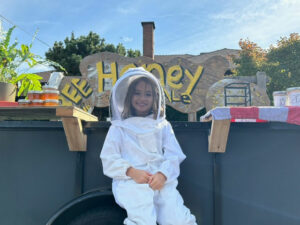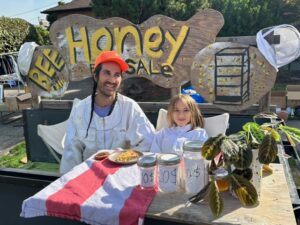By Kathy Crabtree | Contributing Writer

In rural areas, it’s common to see numerous stacked white boxes lining meadows and fields sitting back from the highways. These are beehives, owned by beekeepers. However, residents would be surprised to learn that Concordia has a few hives of its own. One such hive is owned by an intrepid 8-year-old Buckman Elementary School pupil named Mable Bagerski. For the last two years, Bagerski has been helping her mom, Libby, and her father, Adam, care for and harvest the family honey to sell to the community.
During the summer and early fall, the Bagerski family sets up a beehive box called an apiary. A hive starts with 10,000–20,000 worker bees and one queen bee. While the worker bees collect nectar from flowers, the queen births new honey bees, which adds 20,000– 30,000 additional workers a year. Stored in hives, the nectar breaks down into simple sugars. Using special equipment, the Bagerskis then extract the honey from honeycomb, a hexagon-shaped beeswax storage structure created by the bees.

“I help open the hives and hold the frames while wearing my bee suit outfit,” Bagerski says, while sitting in the trailer her family uses to sell their honey. She also fills jars with honey and makes labels. Bagerski says the funnest part is her and her dad working together to harvest the honey because he makes her laugh, like by “pointing out that the queen bee has a bigger butt than the other bees.”
“The hardest part is staying calm around the bees when harvesting and trying not to ‘squash’ the queen,” says Bagerski, who does admit to being stung once. When questioned why she decided to work with stinging insects, she responds, “I thought it would be cool to look at them up close.”
According to the National Agricultural Statistics Service (NASS), honey bees pollinate 130 types of fruit, nuts and vegetables in the U.S. each year, totalling about $15 billion worth of crops. The Oregon Department of Agriculture requires every person who owns, or oversees, five or more colonies of bees to register their hives each year.
Data from the Economic Research Institute says that the average hive produces an average of 30–60 pounds of honey annually, and that a strong healthy colony could produce up to 100 pounds. Most natural honey sells for $5 -$10 a pound. An average honey bee produces ½ teaspoon of honey a year, and it is common for a healthy hive to have 50,000 bees in residence, so annual income for a beekeeper would average $300–$600 a year per hive.
The greatest takeaway lesson Bagerski’s learned from beekeeping is “how bees help us survive. It is important for us to protect the bees and keep providing a safe place for them.” If you’re not afraid of getting stung, Bagerski recommends that anyone interested in harvesting their own honey become a beekeeper. “Not only do you get free honey for yourself, but you can make money, too.”
Kathryn Crabtree is a retired Nursing Educator and author of books that celebrate women of a certain age- invisible to many, who use their deductive reasoning to solve mysteries. The bad guys never see them coming.